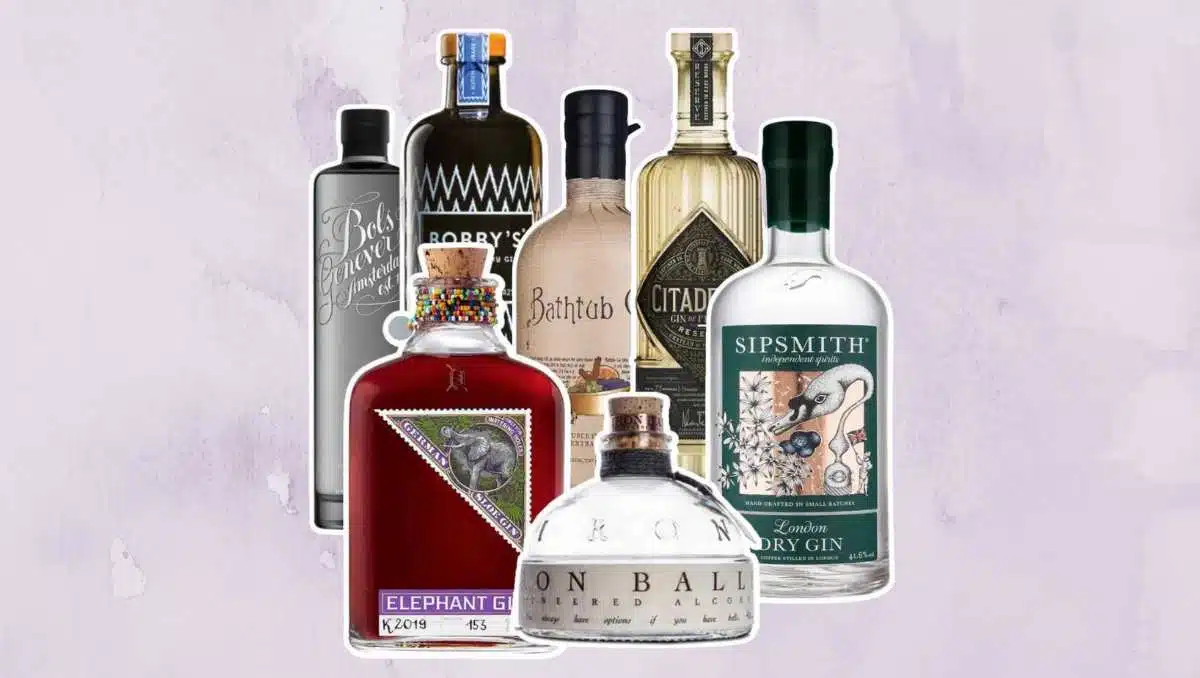In the past decade years, hundreds of new brands entered the gin market. It seems that gin has never been as popular as it is today. Perhaps not in England, but it is definitely true when looking at it on a global scale. -And there is no end in sight.
Like other spirits, you can classify gin by different types and styles, each with its own characteristics and additional regulations beyond the EU definition of gin.
Time to look at the 9 different types of gin, what they taste like, and what makes them unique.
1. Distilled Gin
According to EU law, a distilled gin requires a base alcohol with an "initial alcoholic strength of at least 96 % vol.". Further, at least juniper berries need to be present during this distillation. Other botanicals can be part of it but can also be macerated later.
Thus, the designation Distilled Gin mainly serves the purpose of telling it apart from cold-compounded or Bathtub Gins, generally regarded as inferior.
Specifications:
- Re-distilled at least once with juniper berries
- Contains at least 37.5% alcohol
Recommended Distilled Gin: Iron Balls Gin
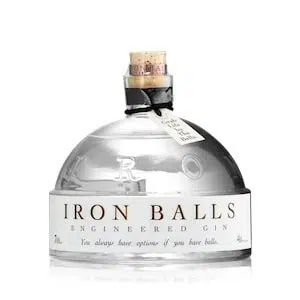
2. Dry Gin
The term "Dry Gin" is not regulated but is nevertheless one of the most used terms to describe gin. Often, brands create related but unique expressions, like Monkey 47, who classify their gin as Schwarzwald Dry.
"Dry" implies that these Gins contain less residual sugar than others. As per EU regulation that applies to all kinds of spirits, producers can only use the term "dry" when their "spirit drink has not been sweetened." [1]
Since there are no further restrictions to this category, Dry Gin can be colored or flavored via cold compounding.
Specifications:
- Must contain at least 37.5% of alcohol by volume
- Must not be sweetened
Recommended Dry Gin: Monkey 47 Dry Gin

3. London Dry Gin
Contrary to popular belief, London Dry Gin does not have to be made in London. Instead, the terminology describes specific production methods and processes. It is the most popular type of gin and also has the strictest rules.
The majority of the leaders in the gin market are London Dry Gins. Best-sellers like Beefeater, Tanqueray, Gordon's, and Bombay Sapphire belong to this category.
To be able to carry this term, these products have to fulfill a long list of requirements:
- Distilled from a spirit with an initial alcoholic strength of at least 96%. (like distilled gin)
- Can only be made from ethyl alcohol of agricultural origin that contains a max. of 5 grams of methanol per hectolitre of 100 % vol. alcohol.
- The resulting distillate needs to contain at least 70% ABV but can be reduced by adding water later.
- The final product must have at least 37,5% alcohol.
- Distilled with natural botanicals in the still, all at the same time.
- Clear and transparent (you can only add water, no coloring)
- No sugar or flavor addition afterward.
- A total sugar content of less than 0.1gr/L
Recommended London Dry Gin: Sipsmith London Dry Gin

4. Plymouth Gin
Plymouth Gin technically is both, a brand and a type of gin because currently, there is only one distillery making it.
This gin style became very popular when mentioned in the Savoy cocktail book. In total, there were 23 cocktail recipes in this book using it.
It is the main reason it was one of the most popular gins in the first part of the 20th century.
When it comes to flavor, the Plymouth Gin is often described as a little smoother than a typical London Dry Gin. It also has a pronounced citrus note, and you get a spicy finish from the mix of seven botanicals; -One of them is Orris roots.
Combined, these botanicals create a fantastic earthy note, making it a perfect ingredient for many tasty Gin cocktails like Dry Martinis, Dirty Martinis, and Negronis.
Specifications:
- Must contain at least 37.5% ABV
- Needs to be produced in a designated area - Plymouth
- Restrained juniper flavor and more pronounced earthy notes
Recommended Plymouth Gin: Plymouth Gin
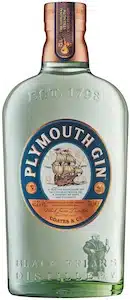
5. Old Tom Gin
Originally Old Tom was a sweetened style of gin less heavy on botanical flavors. It is often seen as a missing link between Genever, the forerunner of gin, and London Dry.
As with New Western Dry Gin, there are barely any regulations for making an Old Tom Gin. It can be aged or unaged, sweetened or not, and based on neutral or non-neutral spirits.
It is richer than a London Dry and works nicely in many classic gin drinks. For instance, it's a superb fit for cocktails like the Tom Collins, Martinez, and Ramos Gin Fizz.
Specifications:
- Must contain at least 37.5% ABV
- The dominant botanical is juniper
Recommended Old Tom Gin: Ransom Old Tom Gin
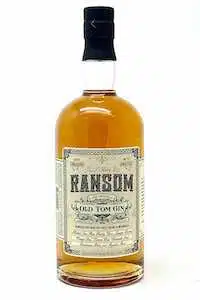
6. Aged Gin / Reserve Gin
Reserve gin or aged gin means that the spirit rests in wooden barrels for an extended time to alter its taste. Aging gin in wooden casks is not a new but a rediscovered trend. In general, gin does not have to be aged, but doing so can bring new and unexpected flavors to it.
Like other aged spirits, gin absorbs the notes of wooden barrels, and its color changes slightly. It has an influence on the taste, softens its bite, and makes the spirit more mellow.
Some find this type appealing, while others consider it merely a new way to increase prices. Yet, regardless of personal opinions, they certainly bring new flavors and variations.
Specifications:
- Must contain 37.5% of alcohol by volume
- Must be aged in a wooden cask or barrel
Recommended Aged Gin: Citadelle Reserve Gin

7. New Western Dry Gin
New Western Dry is relatively new. Around the Millenium, several gin crafters tried to push the boundaries with less juniper-forward creations. Inspired by brands like Hendrick's Gin and Bombay Sapphire, the goal was to create a less juniper-driven spirit with new and exciting botanicals.
One of the Founders of Aviation Gin came up with the term New Western Dry Gin as he felt that this category needed a name to continue to grow and establish itself.
Now, the category is also called "New Wave" or simply "Contemporary" as these terms are more neutral in regards to geographic origin.
Specifications:
- Must contain at least 37.5% ABV
- Less juniper-driven
- Often flavored with unique and regional botanicals
Recommended New Western Dry Gin: Bobby's Schiedam Dry Gin

8. Compound / Bathtub Gin
This is the least popular type in this list due to its questionable quality. A cold compounded gin, referred to as Compound or Bathtub gin, is not distilled with botanicals. Instead, the botanicals are added to a neutral spirit to macerate.
Due to this technique, the gin is prone to change in taste and color over time. Also, if the botanicals are not filtered correctly after maceration, the tiny parts of the botanicals will keep floating in the spirit and developing flavor and color over time.
However, this method is the easiest for making your own gin at home. The results won't be top quality, but it is fun to do - and you get a better understanding of which botanicals work together.
Specifications:
- Contains at least 37.5% of alcohol
- All botanicals are macerated in neutral spirit only; no additional distillation
Recommended Bathtub Gin: Bathtub Gin by Professor Cornelius Ampleforth
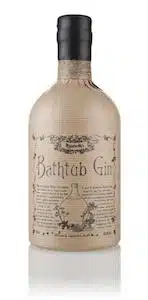
9. Sloe Gin
Sloe Gin technically isn't a gin but a liqueur based on gin. Sugar and sloe berries are added and rest in jars for about three months. The final product typically contains between 25% and 30% alcohol. The sloe berries give the liquor a distinctly deep and dark red color.
In this particular case, the minimum amount of alcohol this liqueur needs to contain to be called a "Sloe Gin" is 25%. This new law was passed by the EU and came into force in early 2023.
Specifications:
- Contains at least 25% of alcohol
- Flavored with sloe berries and sweetened with sugar
Recommended Sloe Gin: Elephant Sloe Gin

The Original: Genever
Genever is the original from the Netherlands and Belgium. Dating back to the 16th century, it's actually a cross between gin and whiskey.
The spirit is made from malted barley, just like whiskey, but is then flavored with juniper and other botanicals to get a more robust and complex flavor profile.
After being distilled from a malted grain mash and flavored with botanicals, Genever is often cask aged for 1-3 years. There are two versions of Genever - Oude (old) and Jonge (young).
Old Genever is the original style and is relatively sweet and aromatic. Young Genever is drier and has a lighter body.
Specifications:
- Distilled from malted grain mash
- Predominantly flavored with juniper
- Must contain at least 35% of alcohol
Recommended Genever: Bols Barrel Aged Genever
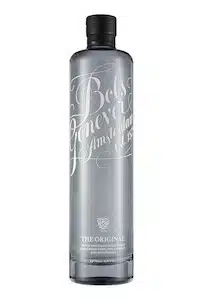
Which type of Gin is the best?
There's no best type of gin, and the answer totally depends on you. Do you want to drink it neat or use it in cocktails? If used in cocktails, which one exactly? Do you prefer strong juniper notes or not?
Every type and even every product is different. Yet, of course, there are some things you should consider choosing your best fit.
An Old Genever usually works great in an Old fashioned. A Plymouth Gin works great in Martinis and Negronis. For a less juniper-forward Gin Tonic, opt for New Western Dry Gin. If you want to drink gin neat, try Aged Gin.

